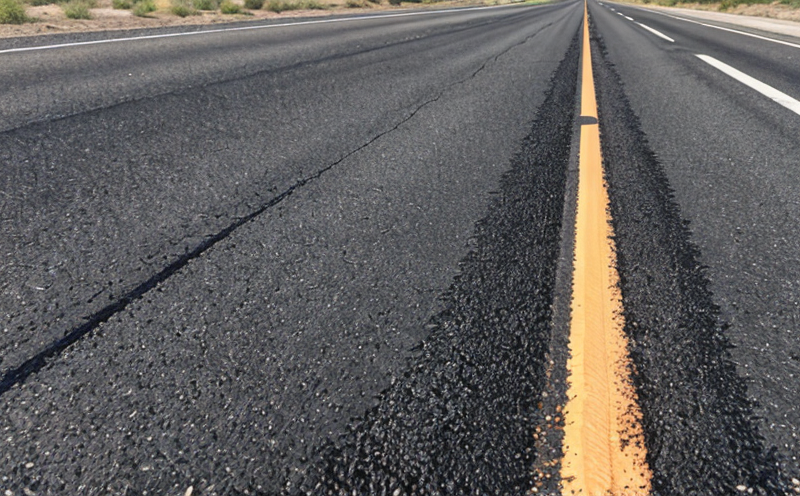Optical Microscopy Defect Characterization Test
The Optical Microscopy Defect Characterization Test is a critical diagnostic tool used to assess the integrity and quality of asphalt and pavement materials. This test is particularly important in the building and infrastructure sector where durability, longevity, and safety are paramount. By using advanced optical microscopy techniques, we can identify microscopic defects within the sample that might otherwise go unnoticed during visual inspections.
The process begins with the collection of a representative sample from the construction site or laboratory. The sample is then prepared meticulously to ensure that it accurately reflects the conditions under which the pavement will be used. This preparation includes cleaning and cutting the sample into sections suitable for examination under the microscope. Once prepared, the samples are examined using optical microscopes equipped with high-resolution cameras capable of capturing detailed images.
The primary goal of this test is to detect and characterize various types of defects such as voids, inclusions, aggregate distribution irregularities, and other anomalies that could affect the performance of the pavement. These defects can significantly impact the load-bearing capacity, water permeability, and overall lifespan of the structure. By identifying these issues early on, engineers and construction professionals can take corrective actions to ensure compliance with industry standards and specifications.
Optical microscopy is particularly effective at revealing fine details that are not apparent through simpler methods like visual inspection or basic mechanical testing. For instance, it allows us to observe how different aggregates interact within the binder matrix, which influences the pavement's strength and flexibility. Additionally, this test can help pinpoint specific areas where further investigation may be required using more advanced techniques such as scanning electron microscopy (SEM).
During the analysis phase, our experienced technicians meticulously record all observed defects along with their location and extent. This information is then compiled into a comprehensive report that includes detailed images captured during the examination process. The report also outlines recommendations for addressing any identified issues based on established guidelines from recognized standards organizations such as ASTM International.
In summary, the Optical Microscopy Defect Characterization Test plays an essential role in ensuring high-quality asphalt and pavement construction by providing precise information about the condition of the materials used. This data enables stakeholders to make informed decisions regarding quality control measures necessary for meeting regulatory requirements while enhancing overall project performance."
Applied Standards
| Standard | Description |
|---|---|
| ASTM E1546-19 | This standard specifies procedures for the examination of bituminous paving mixtures using optical microscopy. It covers the preparation and mounting of specimens, as well as the evaluation criteria used to assess the quality of these materials. |
| ASTM D3274-18 | This standard provides guidelines for the preparation and examination of asphalt concrete cores by means of optical microscopy. It focuses on identifying and quantifying various defects present in the core specimens, including voids, segregation, and other imperfections. |
| EN 12697-3:2004 | This European standard outlines the procedures for examining bituminous paving mixtures using optical microscopy. It emphasizes the importance of proper specimen preparation and evaluation methods to ensure accurate results. |
| ISO 18559:2017 | The International Organization for Standardization has established this standard to provide a framework for examining asphalt concrete mixtures using optical microscopy. It sets forth specific requirements regarding specimen preparation, imaging techniques, and interpretation guidelines. |
| ASTM E435-18 | This standard provides detailed instructions on how to perform light microscopic examination of bituminous paving materials. It includes recommendations for equipment calibration, sample handling procedures, and data recording practices. |
| EN 12697-1:2004 | A European standard that specifies the requirements for the preparation of specimens intended for optical microscopy examination of bituminous paving mixtures. It ensures consistency across different laboratories performing similar analyses. |
Scope and Methodology
The scope of our Optical Microscopy Defect Characterization Test encompasses the entire lifecycle of asphalt and pavement testing, from initial sample collection through final report generation. Our methodology follows stringent protocols based on internationally recognized standards to ensure accuracy and reliability.
Upon receipt of a new batch of samples, we immediately begin preparing them for examination by cleaning and cutting them into appropriate sections. Each section is carefully mounted onto slides suitable for use with optical microscopes. Once prepared, the specimens are examined under high-power magnification using advanced instruments capable of capturing detailed images at resolutions down to 0.2 micrometers.
The examination process involves systematic observation of each sample across multiple fields of view to ensure comprehensive coverage. During this stage, our team meticulously notes all defects observed, including their size, shape, and distribution within the material matrix. This information is documented in real-time using specially designed software that integrates with our database management system.
Following completion of the visual inspection, we generate a detailed report summarizing all findings along with recommendations for addressing any deficiencies detected during the test. The report includes high-resolution images captured throughout the examination process, ensuring transparency and reproducibility. Additionally, it provides insights into potential causes of observed defects and suggests best practices to minimize their occurrence in future projects.
Our approach ensures that every aspect of the testing process adheres strictly to established guidelines set forth by relevant standards bodies like ASTM International and ISO. By doing so, we maintain consistency across all tests conducted within our laboratory, thereby enhancing trustworthiness among clients and stakeholders alike."





